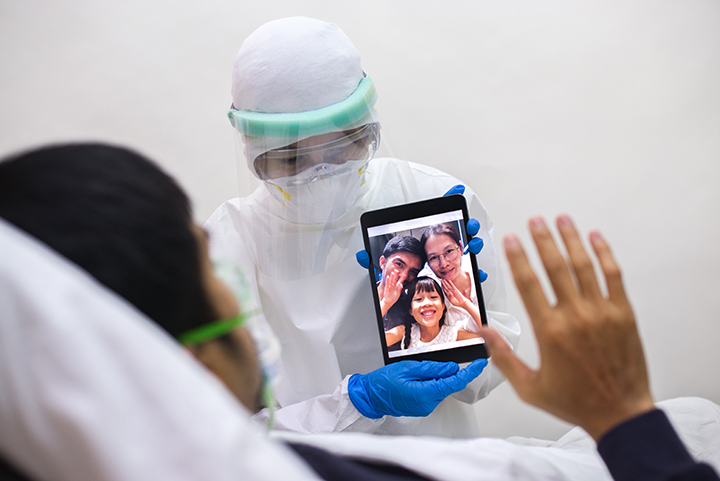For the foreseeable future, efforts to minimize human contact will remain in place as part of the response to the COVID-19 pandemic. This is an important step in providing us with the necessary time to learn about the novel coronavirus while slowing the spread of infection, but it also results in visitor limitations for hospitals, nursing homes and medical practices. Logically, many of us understand and accept this. Emotionally…forget about it. No matter how kind and compassionate we are when we explain the new rules, it’s a terrible feeling when we segregate people from the ones they love.
The negative impact of isolation and a lack of socialization are well documented as leading to the development or exacerbation of mental illnesses such as depression and anxiety, as well as a host of other adverse health conditions that can result in premature death. While better parking and fewer lines in the cafeteria are nice, we should consider the reduced quality of life for our patients and the anguish they, and their loved ones, are subjected to through physical separation. If you entered healthcare to help people, then you likely do not subscribe to this being a good trade-off.
So, what can we do? If we take the same approach as we have to hospital visitor policies (limiting risk), by minimizing the impact of isolation and lack of socialization, we might have a chance at salvaging a greater number of hearts, souls, and psyches. To be successful, this approach needs buy-in from both healthcare institutions as well as those working in those institutions.
The good news is that many hospitals and healthcare facilities have purchased tablets and the technology needed to allow for virtual visits between patients and their loved ones; where this is not available, healthcare staff are helping patients communicate with loved ones via their personal cell phones. Of course, this becomes one more added responsibility for the already stretched-too-thin healthcare worker. Logically, we know virtual visits need to happen. If we do not, however, fully grasp the emotional impact of virtual visits, we might fail to prioritize this intervention as part of the treatment and healing process.
A fundamental practice in my work as an oncology nurse is to reduce the uncertain and the unfamiliar as much as possible for patients and their loved ones. We know this aids in healing and improves outcomes. Nursing theory teaches us that illness causes a disruption in normal life and affects all aspects of life, including physiological functioning, social interactions, and the concept of self. In our specialty we’re taught to recognize that many behaviors, such as incessant calling by family and friends for patient updates, stern scrutiny of plans of care, explorations into alternative treatment methods, and the voluminous questions and answers they glean from online searches are all an attempt to control the uncontrollable and to understand what is happening. We encourage and advocate for family/friend involvement to help support both patient and loved ones in accepting the unacceptable.
Now, enter COVID-19. Other areas of healthcare are expected to understand a whole new dimension of illness and patient care—the unknown and unpredictable—that screams the need for the usual and familiar. The same can also be said of those working outside of healthcare. We humans seek an ongoing semblance of normalcy and control, and we are all looking to each other to provide that. Maintaining a pipeline for human communication is proving to be a key element of stability during these unprecedented times. After decades of criticism that cell phones and virtual technology create social isolation, we have come full circle. In present day, pandemic society, this technology is the very thing keeping us connected to each other.
The Theory of Illness Trajectory, developed by Weiner and Dodd, focuses on the disruption that an illness causes to one’s normal life: Because the processes surrounding the disruption of illness are played out in the context of living, coping responses are inherently situated in sociological interactions with others. Coping, according to this theory, is often described as a compendium of strategies used to manage the disruption. Consider our common practice of taking a lunch break with coworkers. This social interaction is normal and allows us to process, make sense of, and ultimately accept the events of our workday within the confines of our familiar and grounding routine. For patients and loved ones, normalcy is a method of healing. Just as a simple lunch break keeps us going, a daily FaceTime, Zoom or Jitsi can do the same for our patients and their loved ones; the continued communication creates a normalcy and provides patients and their loved ones with something to control.
While we remain inundated with overfilled emergency departments, inpatient volumes, personal protective equipment, and policy change after policy change, let us not forget that we remain human. Humans need humans. We evolved over the centuries into social creatures and it is how we survive. Consider the words of Greek philosopher Aristotle, “Man is by nature a social animal; an individual who is unsocial naturally and not accidentally is either beneath our notice or more than human. Society is something that precedes the individual. Anyone who either cannot lead the common life or is so self-sufficient as not to need to, and therefore does not partake of society, is either a beast or a god.”
Carolina Starr-Manning is nurse manager, inpatient oncology, at Baystate Medical Center in Springfield, Massachusetts.
References
- Gabbatt A. ‘Social recession’: how isolation can affect physical and mental health. The Guardian. https://www.theguardian.com/world/2020/mar/18/coronavirus-isolation-social-recession-physical-mental-health. Accessed November 30, 2020.
- Wiener C, Dodd M. Theory of Illness Trajectory. In: Nursing Theorists and Their Work. Maryland Heights, MO: Mosby; 2010:638-655.
- Sreenivasan S. Why We Need Each Other. Psychology Today. https://www.psychologytoday.com/us/blog/emotional-nourishment/201612/why-we-need-each-other. Published December 14, 2016. Accessed November 30, 2020.
- A quote from Politics. Goodreads. https://www.goodreads.com/quotes/183896-man-is-by-nature-a-social-animal-an-individual-who. Accessed November 30, 2020.



















1 Comment.
I work during night shift in an acute rehab where we get some post-COVID patients and where all of our patients are affected by visitation restrictions and a heightened fear level due to the pandemic. You are so right about time constraints. The increase in acuity has not been met by any change in staffing algorithms and also tends to have us so medically focused that it is easy to forget the psychosocial and spiritual needs of our patients. The first few hours of the shift are a race to get through the med pass, treatments, and hygiene, and then the patients should be sleeping. This leaves little time for setting up FaceTime visits, etc.
However, there are interventions that can take place during even the briefest patient encounter: Talk about normal things — what’s on TV, what kind of work the patient does/did, what the weather is doing, etc. Ask about their family. Make sure their cellphone is charged. Most of all, listen, care, and at least make an effort to address their concerns. It never ceases to amaze me how the smallest things can make the biggest difference.